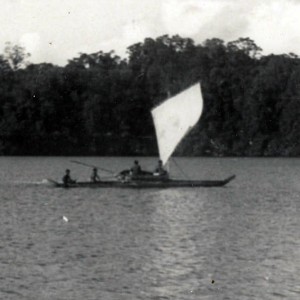Learning to Sail in a Digital World
Life online is a jumble. E-mail, tweets, instant messages, news, sound bites, video clips, blogs, status updates, rush before our eyes.
Printed books offer an escape. You know what a book is when you pick it up. You know that the words you start reading will be the words you finish reading. They will be the same words you can go back to when you need a quote or to refresh an idea. A book doesn’t update. It doesn’t rotate out of the cycle on your screen. It doesn’t disappear when it is twenty-four hours old. New books don’t force it down the queue.
Almost a century ago, H. A. Calahan wrote about learning to sail*. He argued that you can never “find the world of waters” in a motor boat because a motor boat “carries part of the shore with it.” The engine, the fuel, the vibration, the noise of a machine tie you to shore and interrupt your connection to the water. His argument resonates with the change from print to digital reading. You can never really bond with a book when you read electronically. You are always reliant on the machine. You can’t see ahead. You have the worries of battery power and signal strength. You know in the back of your head that a system manager may reach out and delete your content. Or an alert will interrupt your screen just when you are integrating some new idea into your way of thinking.
We know that books are bulky and slow. You can’t search a book in a few clicks. At best you can refer to an index. But when you do learn what a book contains you know you can rely on it.
When you read a book you are alone. You are not connected to a server or a network. It is just you and the author’s words. You have to rely on your own knowledge and experiences to evaluate the worth of the ideas on the pages you turn. You have to imagine the images the author worked to share with you with no help from stock Images. You have to work a little harder to understand everything, but you gain the satisfaction of knowing that you do understand everything. You didn’t just follow a link to a definition that you will forget by the time you device loads a new screen.
Books are expensive. Trees must be cut down and pulped. Paper must be made in vast dedicated factories. Editors and publishers must invest their time to select books they value. Printers use steel and electricity and ink to transform nature into ideas. All of that work helps to ensure that a good book was worthy of the effort for it to find its way to a reader.
Modern technology has, we admit, reduced the value of the book. It is easier to print a book today than ever before. You enter some content into your computer along with your credit card number and 10 days later a printed bound book arrives at your door. But the great books of the past still hold sway and new books continue to bring us new ideas.
Our library, like many modern libraries, provides electronic access to databases, journals, and e-books. So much content that no one person could ever read it all. We are happy to do so because it supports our scholarly community. But we also want to invite you to take some time and experience a real book from time to time.
Emily Dickinson said “There is no frigate like a book, To take us lands away…” And with that we see the difference between print and digital. Print can take us away while digital brings everything to us. If we want to find new things we must take the time to look beyond where we already are.
Photo: BYU-Hawaii Collection, Call Number PH 2.003, Photographer Bryant, Edward K., Title “Native people on a canoe in the ocean,” ca 1940.
*Learning to sail
Calahan, H. A. (Harold Augustin), b. 1889.
Personal Author: Calahan, H. A. (Harold Augustin), b. 1889.
Title: Learning to sail.
Edition statement: New ed., with supplementary chapter.
Publication info: New York, The Macmillan company, 1937 [c1933].
Physical description: xxii p., 1 l., 345 p. incl. front., illus., diagrs. ; 20 cm.
Subject term: Sailing.
LCCN: 33035388
Holdings
HBLL
Copy Material Location
GV 811 .C3 1937 1 Book Harold B. Lee Library Bookshelves
